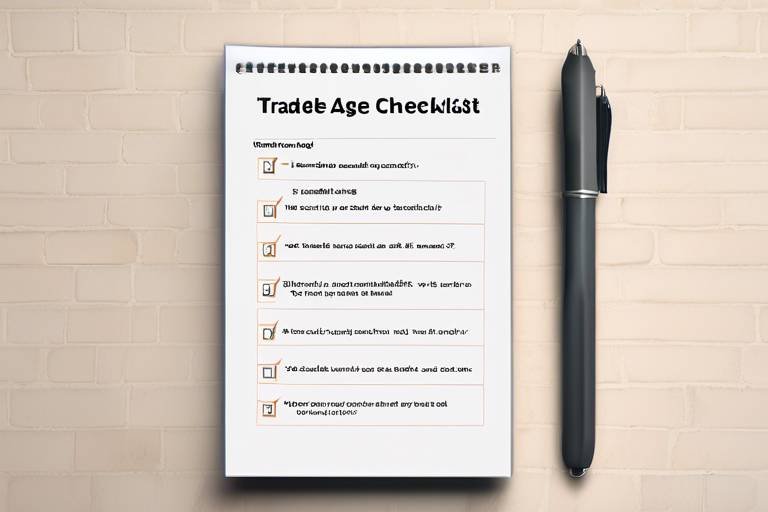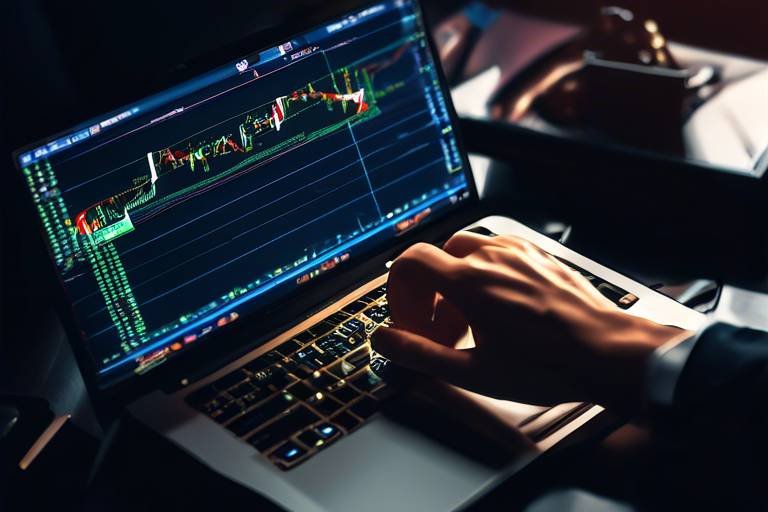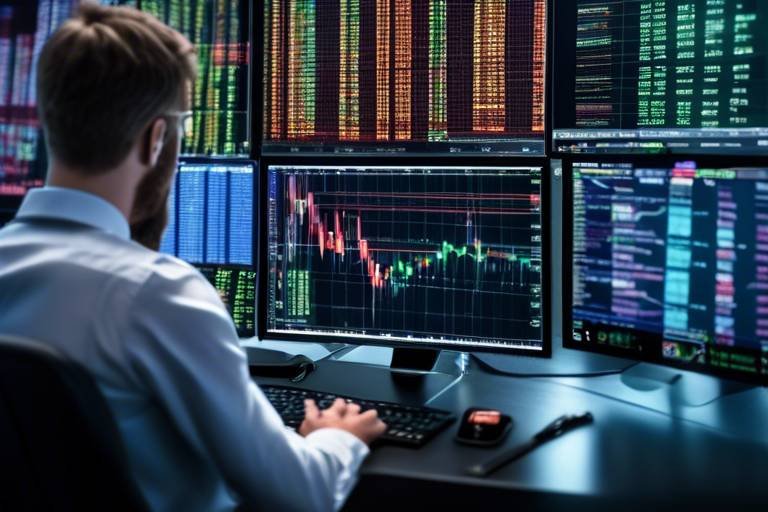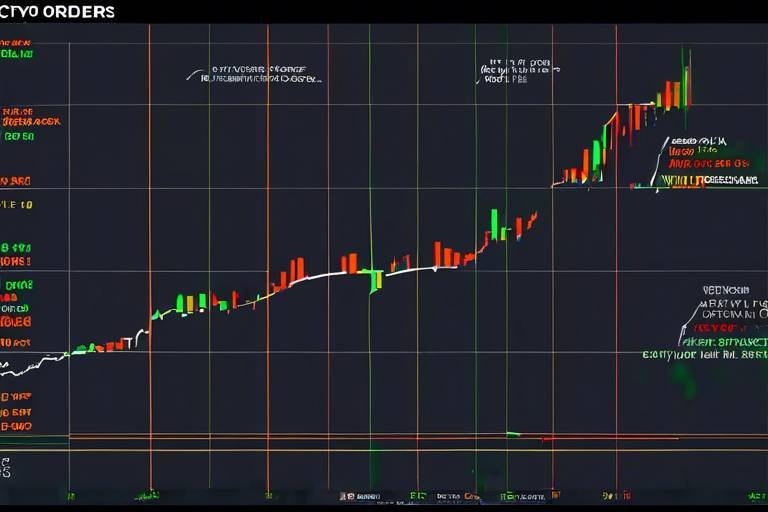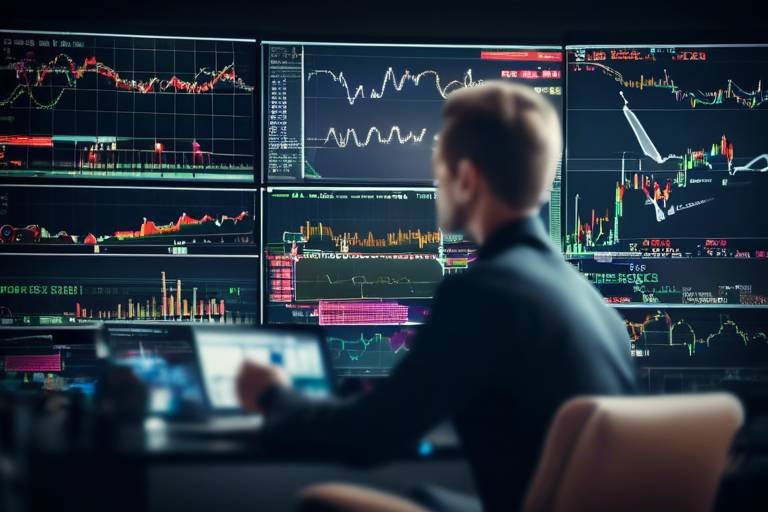The Role of Backtesting in Developing Trading Strategies
Have you ever wondered how successful traders develop their strategies? The secret often lies in a process called backtesting. This method allows traders to evaluate their trading strategies using historical data, providing a glimpse into how their tactics would have performed in the past. Think of it as a time machine for traders, offering insights that can shape future decisions and enhance profitability.
Backtesting serves as a crucial step in the strategy development process. It not only helps traders identify the strengths and weaknesses of their strategies but also provides a framework for refining those strategies before risking real capital. By simulating trades based on historical data, traders can uncover patterns and trends that might not be apparent when analyzing current market conditions. This practice is akin to a rehearsal before the big performance, allowing traders to fine-tune their approach and gain confidence in their decisions.
In the world of trading, where every decision can have significant financial implications, the importance of backtesting cannot be overstated. It empowers traders to make informed choices, reduces the likelihood of emotional decision-making, and ultimately leads to more consistent results. But how do traders go about backtesting their strategies effectively? That's where understanding the nuances of historical data and choosing the right backtesting tools come into play.
As we delve deeper into the significance of backtesting, it's essential to recognize that not all historical data is created equal. Traders must be meticulous in selecting the data they use, ensuring it is both accurate and comprehensive. This selection process forms the bedrock of any backtesting effort, as it directly impacts the reliability of the results. Furthermore, the methodologies employed during backtesting can vary widely, highlighting the need for a tailored approach that aligns with individual trading styles and objectives.
In summary, backtesting is an indispensable component of developing effective trading strategies. It not only provides valuable insights into past performance but also equips traders with the tools necessary to adapt and thrive in an ever-changing market landscape. So, whether you're a seasoned trader or just starting, embracing the art of backtesting could very well be your ticket to enhanced decision-making and improved profitability.
- What is backtesting? Backtesting is the process of testing a trading strategy on historical data to evaluate its effectiveness.
- Why is historical data important? Historical data is crucial for backtesting as it provides the foundation for evaluating trading strategies, allowing traders to simulate various market conditions.
- What are common mistakes in backtesting? Common mistakes include overfitting strategies to historical data and ignoring transaction costs, which can lead to inaccurate results.
- How can I integrate backtesting with live trading? Integrating backtested strategies into live trading requires careful consideration and adaptation based on real-time data and market conditions.

Understanding Backtesting
Backtesting is an essential process in the world of trading, serving as a critical tool for evaluating the effectiveness of trading strategies. Imagine you’re a pilot preparing for a flight; you wouldn’t just hop into the cockpit without checking the weather, right? Similarly, traders need to assess how their strategies would have performed under various market conditions before they put their hard-earned money on the line. By applying a trading strategy to historical data, traders can gain valuable insights into its potential performance, helping them make informed decisions in real-time.
The beauty of backtesting lies in its ability to provide a simulation of how a trading strategy might have fared in the past. This involves using historical price data, trading volumes, and other relevant metrics to recreate market scenarios. Think of it like a rehearsal for a play; you want to ensure that everything runs smoothly before the opening night. By backtesting, traders can identify strengths and weaknesses in their strategies, allowing for adjustments and refinements that could lead to better outcomes in actual trading.
Moreover, backtesting is not just about looking at profits and losses. It also helps traders understand the risk-reward ratio of their strategies. For instance, a strategy that generates high returns but comes with significant risk may not be suitable for every trader. By analyzing historical data, traders can gauge how much drawdown they might expect and whether they can tolerate that level of risk. This understanding can be pivotal in developing a robust trading plan.
However, backtesting is not without its challenges. It requires careful selection of historical data and an understanding of the market conditions during that time. Traders must ensure that the data they are using is accurate and comprehensive. Inaccurate data can lead to misleading results, much like a chef using spoiled ingredients in a recipe. Thus, traders should be diligent in their data sourcing.
In summary, backtesting is a crucial step in the trading strategy development process. It allows traders to simulate their strategies against historical data, understand potential risks, and refine their approaches before entering the live market. As the saying goes, "Failing to prepare is preparing to fail." By investing time in backtesting, traders can significantly enhance their chances of success in the ever-volatile world of trading.

Importance of Historical Data
When it comes to backtesting, the significance of historical data cannot be overstated. This data serves as the backbone of any trading strategy evaluation, allowing traders to simulate their strategies under various market conditions. Think of historical data as a time machine; it enables you to look back and see how your strategies would have performed in different scenarios. Without it, you’re essentially flying blind, making decisions based on gut feelings rather than solid evidence.
Accurate and comprehensive historical data allows traders to assess the robustness of their strategies over time. It provides insights into how market dynamics change and how different factors influence asset prices. For instance, during a financial crisis, a strategy that worked well in a bull market might falter dramatically. By analyzing historical data, traders can identify these shifts and adapt their strategies accordingly.
Moreover, the quality of your historical data can significantly impact your backtesting results. If the data is faulty or incomplete, the insights you gain will be skewed, leading to poor decision-making. Here are some key types of historical data that traders should consider:
- Price Data: This includes historical prices of assets, which are essential for analyzing past performance. Traders utilize this data to identify trends, patterns, and potential entry and exit points for their strategies.
- Volume Data: Volume data reflects the number of shares traded during a specific period. Analyzing this data helps traders understand market sentiment and the strength of price movements, which can be crucial for validating trading strategies.
- Economic Indicators: These indicators, such as interest rates and employment figures, provide context for market movements, helping traders gauge the overall economic environment.
In summary, historical data is not just a tool; it’s a vital component of successful trading strategy development. By leveraging accurate historical data, traders can gain valuable insights, make informed decisions, and ultimately improve their profitability. So, next time you think about backtesting your strategy, remember that the data you use is just as important as the strategy itself!
Q1: What is backtesting?
A1: Backtesting is the process of testing a trading strategy on historical data to evaluate its effectiveness and see how it would have performed in the past.
Q2: Why is historical data important for backtesting?
A2: Historical data provides the foundation for evaluating trading strategies, allowing traders to simulate various market conditions and assess the robustness of their strategies over time.
Q3: What types of historical data should traders consider?
A3: Traders should consider price data, volume data, and economic indicators to gain a comprehensive view of market conditions and enhance their strategy evaluations.
Q4: How can poor quality historical data affect backtesting results?
A4: Faulty or incomplete historical data can lead to skewed insights, resulting in poor decision-making and ineffective trading strategies.

Types of Historical Data
When it comes to backtesting trading strategies, understanding the available is crucial. Historical data serves as the backbone of any analysis, allowing traders to simulate past market conditions and evaluate how their strategies would have performed. There are several categories of historical data that traders should be aware of, each offering unique insights and helping to refine trading strategies.
First and foremost, we have price data. This includes the historical prices of assets over time, which are essential for analyzing past performance. Traders utilize this data to identify trends, patterns, and potential entry and exit points. For instance, if a trader notices a consistent upward trend in a stock’s price over a specific period, they might consider this a signal to enter a position. Conversely, a downward trend could indicate a good time to sell or avoid buying.
Next up is volume data. This type of data reflects the number of shares or contracts traded during a specific period. Understanding volume is critical because it provides insights into market sentiment and the strength of price movements. A price increase accompanied by high volume typically suggests strong buying interest, while a price increase on low volume may indicate a lack of conviction. Therefore, analyzing volume data can help traders validate their strategies and make informed decisions.
Additionally, we have economic indicators, which can significantly influence market conditions. These indicators include metrics such as GDP growth rates, unemployment rates, and inflation rates. By incorporating economic indicators into backtesting, traders can assess how their strategies would have performed during different economic climates. For example, a strategy that works well in a booming economy may falter during a recession. Recognizing these nuances can help traders adapt their strategies for varying market conditions.
To summarize, the key types of historical data that traders should consider include:
- Price Data: Historical asset prices for trend analysis.
- Volume Data: Trading volume to gauge market sentiment.
- Economic Indicators: Data reflecting economic health that can impact trading performance.
By leveraging these types of historical data effectively, traders can enhance their backtesting processes and develop more robust trading strategies. Remember, the goal of backtesting is not just to find a strategy that worked in the past but to create a framework that can adapt to future market conditions. So, equip yourself with the right data, and you'll be well on your way to making informed trading decisions!
Q: What is backtesting?
A: Backtesting is the process of testing a trading strategy on historical data to evaluate its effectiveness and performance.
Q: Why is historical data important in backtesting?
A: Historical data provides the foundation for evaluating trading strategies, allowing traders to simulate various market conditions and assess the robustness of their strategies over time.
Q: What types of historical data should I use for backtesting?
A: Key types of historical data include price data, volume data, and economic indicators, each offering unique insights for strategy evaluation.
Q: Can backtesting guarantee future success?
A: While backtesting can provide valuable insights, it does not guarantee future success due to the dynamic nature of financial markets.

Price Data
Price data is the lifeblood of any trading strategy. It encompasses the historical prices of assets over time, allowing traders to analyze past performance and make informed decisions about future trades. Think of price data as a time machine; it gives you the ability to look back and see how an asset reacted to various market conditions, news events, and economic indicators. By studying this data, traders can identify trends, spot patterns, and determine potential entry and exit points for their strategies.
When diving into price data, it's essential to understand the different components that make it up. Typically, price data includes the following:
- Open Price: The price at which an asset starts trading during a specific time period.
- Close Price: The price at which an asset finishes trading at the end of that period.
- High Price: The highest price reached during the trading period.
- Low Price: The lowest price during the same period.
Moreover, the visualization of price data can significantly enhance a trader's understanding. Charts, such as candlestick or line charts, provide a visual representation of price movements over time. This visual aspect allows traders to quickly spot trends and reversals, making it easier to formulate strategies. For instance, a series of higher highs and higher lows might indicate a bullish trend, while lower highs and lower lows could signal a bearish market.
In addition to recognizing trends, price data can also be used to apply various technical indicators. Indicators such as Moving Averages, Relative Strength Index (RSI), and Bollinger Bands rely heavily on historical price data to provide insights into market conditions. By integrating these indicators into their analyses, traders can better gauge the strength of a trend or identify potential reversal points.
However, while price data is incredibly valuable, it’s essential to utilize it wisely. Traders should avoid making decisions based solely on historical price movements without considering the broader market context. For example, a stock might have a history of price increases, but if there’s negative news or a shift in market sentiment, that trend could reverse unexpectedly. Therefore, it's crucial to combine price data analysis with other forms of research, such as fundamental analysis and market news.
In summary, price data is a fundamental aspect of trading that provides insights into market behavior and helps traders make informed decisions. By analyzing historical prices, recognizing trends, and applying technical indicators, traders can enhance their strategies and improve their chances of success in the market. Always remember, the past can inform the future, but it’s the present market conditions that ultimately dictate performance.
- What is backtesting? Backtesting is the process of testing a trading strategy on historical data to evaluate its effectiveness.
- Why is historical data important? Historical data provides the foundation for evaluating trading strategies, allowing traders to simulate various market conditions.
- What types of historical data should I use? Price data, volume data, and economic indicators are vital for effective backtesting.
- How can I avoid common backtesting mistakes? Be mindful of overfitting strategies and always account for transaction costs in your evaluations.

Volume Data
Volume data is a powerful tool in the arsenal of any trader. It represents the total number of shares or contracts traded for a specific asset during a given period. Understanding volume can be likened to tuning into the heartbeat of the market; it tells you how alive and active a particular asset is at any moment. When analyzing price movements, volume acts as a confirming signal. For instance, if a stock's price is rising and volume is increasing, it suggests that the upward trend is supported by strong buyer interest. Conversely, if the price is increasing but volume is low, it may indicate a lack of conviction, raising a red flag for traders.
One of the most significant benefits of incorporating volume data into your trading strategy is its ability to provide insights into market sentiment. When you see high volume accompanying price movements, it typically indicates that a significant number of traders are participating in that move, which can enhance the reliability of the trend. On the flip side, low volume can signify that a price move may not be sustainable. Understanding these dynamics can help traders make more informed decisions about when to enter or exit trades.
Moreover, volume data can help identify potential reversals in the market. For example, if a stock has been in a downtrend, but suddenly experiences a spike in volume while the price starts to rise, it could be a sign that a reversal is imminent. This is because increased buying activity may indicate that traders are beginning to see value in the asset, prompting a shift in market sentiment. However, it's essential to combine volume analysis with other indicators to confirm such signals and avoid false breakouts.
To visualize the relationship between price and volume, traders often use charts that display both metrics. A popular method is to overlay volume bars beneath price charts, allowing for easy comparison. Here’s a simple representation:
| Price Movement | Volume Level | Market Sentiment |
|---|---|---|
| Price Increase | High Volume | Strong Bullish Sentiment |
| Price Increase | Low Volume | Weak Bullish Sentiment |
| Price Decrease | High Volume | Strong Bearish Sentiment |
| Price Decrease | Low Volume | Weak Bearish Sentiment |
In summary, volume data is not just a number; it's a crucial aspect of market analysis that can enhance your trading strategies. By paying attention to volume trends, traders can gain a deeper understanding of market dynamics, improve their decision-making, and ultimately increase their chances of success. Remember, trading without considering volume data is like sailing a ship without checking the wind; you might end up off course!
- What is volume data in trading? Volume data refers to the total number of shares or contracts traded for a specific asset during a given time period.
- Why is volume data important? It helps traders gauge market sentiment, confirm price movements, and identify potential reversals.
- How can I analyze volume data? Volume can be analyzed by comparing it with price movements on charts, looking for trends, spikes, and patterns.
- What is a good volume for a stock? A good volume varies by asset and market conditions, but generally, higher volume indicates more interest and liquidity.

Choosing the Right Backtesting Software
When it comes to backtesting your trading strategies, the software you choose can make all the difference. Imagine trying to navigate a ship through stormy seas without a compass. That's what it's like to backtest without the right tools! The right backtesting software can help you analyze your strategies effectively, providing you with the insights needed to make informed trading decisions.
First and foremost, consider the features that the software offers. Look for tools that allow you to test various strategies under different market conditions. Some software includes advanced features like algorithmic trading capabilities, which can automate parts of your strategy testing. Others offer extensive libraries of historical data, which is crucial for conducting thorough analyses. You want a platform that not only allows you to backtest but also provides detailed performance metrics, so you can understand how your strategy would have performed in the past.
Another critical aspect to consider is the user interface. A user-friendly interface is essential for both novice and experienced traders. If the software is too complicated, you might find yourself spending more time figuring out how to use it than actually backtesting your strategies. Look for platforms that offer tutorials, customer support, and community forums. These resources can be invaluable as you learn to navigate the software and leverage its capabilities effectively.
Additionally, data accuracy is non-negotiable. Make sure the software you choose provides accurate and comprehensive historical data. Inaccurate data can lead to misleading results, which can be detrimental when you start trading live. Some platforms may even allow you to import your own data, giving you the flexibility to test your strategies against the most relevant information available.
Cost is another factor to weigh. While some backtesting software options are free, others come with a subscription fee. It's essential to evaluate whether the features offered justify the price. Sometimes, investing in a premium service can save you money in the long run by improving your trading performance. You might want to create a
| Software | Key Features | Price | User Rating |
|---|---|---|---|
| Software A | Advanced analytics, automated trading | $29/month | 4.5/5 |
| Software B | User-friendly interface, extensive data | $49/month | 4.7/5 |
| Software C | Free version available, community support | Free | 4.0/5 |
In the end, choosing the right backtesting software is about finding a balance between features, usability, and cost. Take the time to explore different options, read reviews, and even try out free trials when available. Your trading success may very well depend on the tools you use!
- What is backtesting? Backtesting is the process of testing a trading strategy using historical data to see how it would have performed in the past.
- Why is backtesting important? It helps traders understand the potential effectiveness of their strategies and make informed decisions based on historical performance.
- Can I trust backtesting results? While backtesting can provide valuable insights, it's essential to remember that past performance does not guarantee future results.
- How do I avoid overfitting in backtesting? To avoid overfitting, ensure your strategy is not overly complex and can perform well under various market conditions.

Common Backtesting Mistakes
When it comes to backtesting, even the most seasoned traders can fall into traps that lead to poor decision-making. One of the biggest mistakes is overfitting strategies. This occurs when a trading strategy is excessively tailored to historical data, making it so complex that it loses its effectiveness in real-world scenarios. Think of it like trying to fit a square peg into a round hole; it might look perfect on paper, but when you actually try to use it, it just doesn't work. To avoid this, traders should aim for a balance between fitting the historical data and maintaining a strategy that can adapt to changing market conditions.
Another common pitfall is ignoring transaction costs. Many traders conduct backtests that yield impressive results, only to realize later that they failed to account for the costs associated with executing trades. This oversight can lead to overly optimistic performance metrics. It's akin to running a marathon without considering the fatigue you'll experience; you might think you can maintain a fast pace, but the reality is often quite different. Incorporating realistic transaction costs into your backtesting process is crucial for ensuring that your strategies are viable when it comes time to trade live.
Additionally, traders often overlook the significance of market conditions during their backtests. Historical data is not just a collection of numbers; it reflects various market environments, including bull and bear markets, high volatility periods, and economic downturns. If a trader tests a strategy only during a specific type of market condition, they may find that it performs poorly when faced with different circumstances. Therefore, it's essential to simulate a variety of market conditions to gain a comprehensive understanding of how a strategy might perform over time.
Lastly, failing to validate results can be detrimental. Traders should not only rely on backtesting data but also validate their findings through forward testing or paper trading. This process allows them to see how a strategy performs in real-time without risking actual capital. It's similar to trying out a new recipe; you wouldn't serve it to guests without tasting it first, right? By validating results, traders can gain confidence in their strategies and make necessary adjustments before committing real money.
In summary, avoiding common backtesting mistakes is essential for traders looking to develop effective trading strategies. By being mindful of overfitting, transaction costs, market conditions, and the need for validation, traders can enhance their decision-making processes and improve their chances of success in the markets.
- What is backtesting? Backtesting is the process of testing a trading strategy using historical data to see how it would have performed in the past.
- Why is it important to avoid overfitting? Overfitting can lead to a strategy that performs well on historical data but fails in real market conditions, resulting in potential losses.
- How can transaction costs affect backtesting results? Ignoring transaction costs can make a strategy appear more profitable than it actually is, leading to unrealistic expectations when trading live.
- What should I do if my backtesting results are too good to be true? Consider validating your results through forward testing or paper trading to ensure the strategy's effectiveness in real-time scenarios.

Overfitting Strategies
Overfitting is a common pitfall in the world of trading strategy development. Imagine you’ve crafted a beautiful, intricate tapestry, meticulously weaving each thread to create a stunning design. However, when you hold it up to the light, you realize it’s so tightly woven that it can’t possibly hold up under real-world scrutiny. This is akin to overfitting in trading strategies. When a strategy is overfitted, it means that it has been excessively tailored to historical data, capturing every little fluctuation and noise instead of focusing on the broader market trends. As a result, while it may show impressive performance in backtesting, it often fails to deliver similar results in live trading conditions.
To understand why overfitting is problematic, consider this: if a strategy is too complex, it may not be able to adapt to new, unseen data. It’s like trying to predict the weather based solely on last year’s patterns without accounting for changes in climate. The market is dynamic, and strategies must be robust enough to withstand its ever-changing nature. Here are a few signs that your strategy might be overfitted:
- Excessive Complexity: If your strategy has too many parameters or conditions, it may be a red flag.
- High Backtest Performance: If your strategy shows unrealistically high returns that seem too good to be true, it might be overfitted.
- Poor Out-of-Sample Results: If your strategy performs well on historical data but poorly on new data, it’s a clear indication of overfitting.
To avoid the trap of overfitting, traders should strive for simplicity and generalizability. A solid strategy should capture essential market dynamics without getting bogged down by every minor fluctuation. One effective approach is to use a validation set, where you can test your strategy on a separate dataset that it hasn’t seen before. This helps ensure that your strategy is not just a product of the historical data but is also capable of adapting to future market conditions.
Moreover, employing techniques such as cross-validation can enhance the robustness of your strategy. Cross-validation involves dividing your data into multiple subsets, allowing you to train your strategy on some while testing it on others. This process helps in identifying whether your strategy is genuinely effective or just a fluke of the historical data.
In conclusion, while the allure of a perfectly performing trading strategy can be tempting, it’s essential to remember that simplicity and adaptability are key. By avoiding overfitting, traders can develop strategies that not only shine in backtesting but also hold up in the unpredictable world of live trading.
Q1: What is overfitting in trading strategies?
A1: Overfitting occurs when a trading strategy is too closely tailored to historical data, capturing noise rather than underlying trends, which can lead to poor performance in live trading.
Q2: How can I prevent overfitting in my trading strategy?
A2: To prevent overfitting, aim for simplicity in your strategy, use validation sets to test performance on unseen data, and consider techniques like cross-validation to ensure robustness.
Q3: Why is historical data important for backtesting?
A3: Historical data provides the foundation for evaluating trading strategies, allowing traders to simulate various market conditions and assess how their strategies would have performed over time.

Ignoring Transaction Costs
When it comes to backtesting trading strategies, one of the most common pitfalls that traders fall into is . It's easy to get caught up in the allure of a strategy that shows impressive returns on paper, but if you overlook the costs associated with executing trades, you might be setting yourself up for disappointment. Transaction costs can significantly erode profits and lead to misleading conclusions about a strategy's effectiveness.
Transaction costs encompass a variety of expenses, including brokerage fees, spreads, and slippage. Each of these costs can accumulate quickly, especially for strategies that involve frequent trading. For example, if you plan to execute multiple trades each day, the costs can add up, making a once-profitable strategy turn into a money-loser. It's crucial to factor in these costs when evaluating the viability of your trading approach.
To illustrate the impact of transaction costs, consider the following hypothetical scenario:
| Trade Type | Gross Profit | Transaction Costs | Net Profit |
|---|---|---|---|
| 10 Trades | $1,000 | $200 | $800 |
| 50 Trades | $5,000 | $1,000 | $4,000 |
| 100 Trades | $10,000 | $2,500 | $7,500 |
In the table above, you can see how transaction costs impact net profits as the number of trades increases. While the gross profit grows, so do the transaction costs, which can significantly affect the overall profitability of your strategy. This highlights the importance of incorporating realistic transaction costs into your backtesting process.
Moreover, traders should also consider the impact of market conditions on transaction costs. During periods of high volatility, spreads can widen, and slippage can increase, further inflating your trading expenses. By accounting for these factors, you can better assess the true performance of your strategy under different market scenarios.
In conclusion, ignoring transaction costs during backtesting can lead to a false sense of security and poor trading decisions. To ensure a more accurate evaluation of your trading strategy, always include these costs in your calculations. By doing so, you'll be better equipped to develop strategies that are not only theoretically sound but also practical and profitable in real market conditions.
- What are transaction costs? Transaction costs refer to the expenses incurred when buying or selling assets, including brokerage fees, spreads, and slippage.
- Why is it important to consider transaction costs in backtesting? Ignoring transaction costs can lead to overly optimistic performance results, as these costs can significantly reduce net profits.
- How can I estimate transaction costs for my trading strategy? You can estimate transaction costs by researching your broker's fee structure, analyzing historical spreads, and considering potential slippage during trades.

Integrating Backtesting with Live Trading
Integrating backtested strategies into live trading is like transitioning from a rehearsal to a live performance. While backtesting can provide a solid foundation, the real market is unpredictable, and traders must be prepared to adapt. It’s essential to remember that what worked in the past may not always work in the future. Therefore, flexibility is key. Traders need to be vigilant, continuously monitoring their strategies and adjusting them based on real-time data and changing market conditions.
One of the first steps in this integration process is to set realistic expectations. Many traders fall into the trap of assuming that their backtested results will directly translate into live performance. However, the market is influenced by numerous external factors, including economic news, geopolitical events, and market sentiment. Thus, it’s crucial to have a mindset that embraces both success and failure. After all, every trader has to face the reality that losses are part of the game.
Moreover, risk management plays a pivotal role in this transition. Traders should develop a robust risk management plan that includes setting stop-loss orders and defining position sizes. This ensures that even if a strategy falters in a live environment, the impact on the overall trading account remains manageable. It's like having a safety net; it allows you to take calculated risks without jeopardizing your financial stability.
Another important aspect is the continuous evaluation of strategies. Once a trader moves to live trading, they should regularly assess the performance of their strategies. This includes comparing live results against backtested results to identify any discrepancies. If a strategy is underperforming, it may be time to revisit the backtesting phase, tweak the parameters, or even explore entirely new strategies.
To help visualize the integration process, consider the following table that outlines the key differences between backtesting and live trading:
| Aspect | Backtesting | Live Trading |
|---|---|---|
| Market Conditions | Historical data | Real-time fluctuations |
| Execution | Simulated | Actual trades |
| Emotional Factors | Minimized | Significant impact |
| Transaction Costs | Often ignored | Must be accounted for |
In conclusion, integrating backtested strategies into live trading is a dynamic process that requires a combination of preparation, flexibility, and ongoing evaluation. By being aware of the differences between backtesting and live trading, traders can better manage their expectations and improve their chances of success. Remember, the journey of trading is not just about the strategies you deploy; it’s also about how you adapt to the ever-changing landscape of the markets.
- What is backtesting? Backtesting is the process of testing a trading strategy on historical data to evaluate its effectiveness.
- Why is historical data important? Historical data provides the foundation for evaluating trading strategies and helps simulate various market conditions.
- What are common mistakes in backtesting? Common mistakes include overfitting strategies and ignoring transaction costs.
- How can I integrate backtested strategies into live trading? By setting realistic expectations, implementing risk management, and continuously evaluating your strategies.
Frequently Asked Questions
- What is backtesting in trading?
Backtesting is the process of testing a trading strategy using historical market data to see how it would have performed in the past. It allows traders to evaluate the effectiveness of their strategies before they risk real money in the markets.
- Why is historical data important for backtesting?
Historical data is crucial because it provides the necessary context for evaluating trading strategies. It allows traders to simulate various market conditions, helping them understand how their strategies might react to different scenarios over time.
- What types of historical data should I use for backtesting?
Common types of historical data include price data, volume data, and economic indicators. Each type serves a different purpose; for instance, price data helps identify trends, while volume data provides insights into market sentiment.
- How do I choose the right backtesting software?
Choosing the right backtesting software involves looking for user-friendly interfaces, advanced features, and accurate data. You want a tool that makes it easy to analyze your strategies thoroughly and provides reliable results.
- What are some common mistakes to avoid in backtesting?
Common mistakes include overfitting strategies to historical data and ignoring transaction costs. Overfitting can make a strategy less effective in real markets, while not accounting for transaction costs can lead to unrealistic performance expectations.
- How can I integrate backtested strategies into live trading?
Integrating backtested strategies into live trading requires flexibility. Traders should be prepared to adjust their strategies based on real-time data and market conditions to enhance performance and manage risks effectively.





